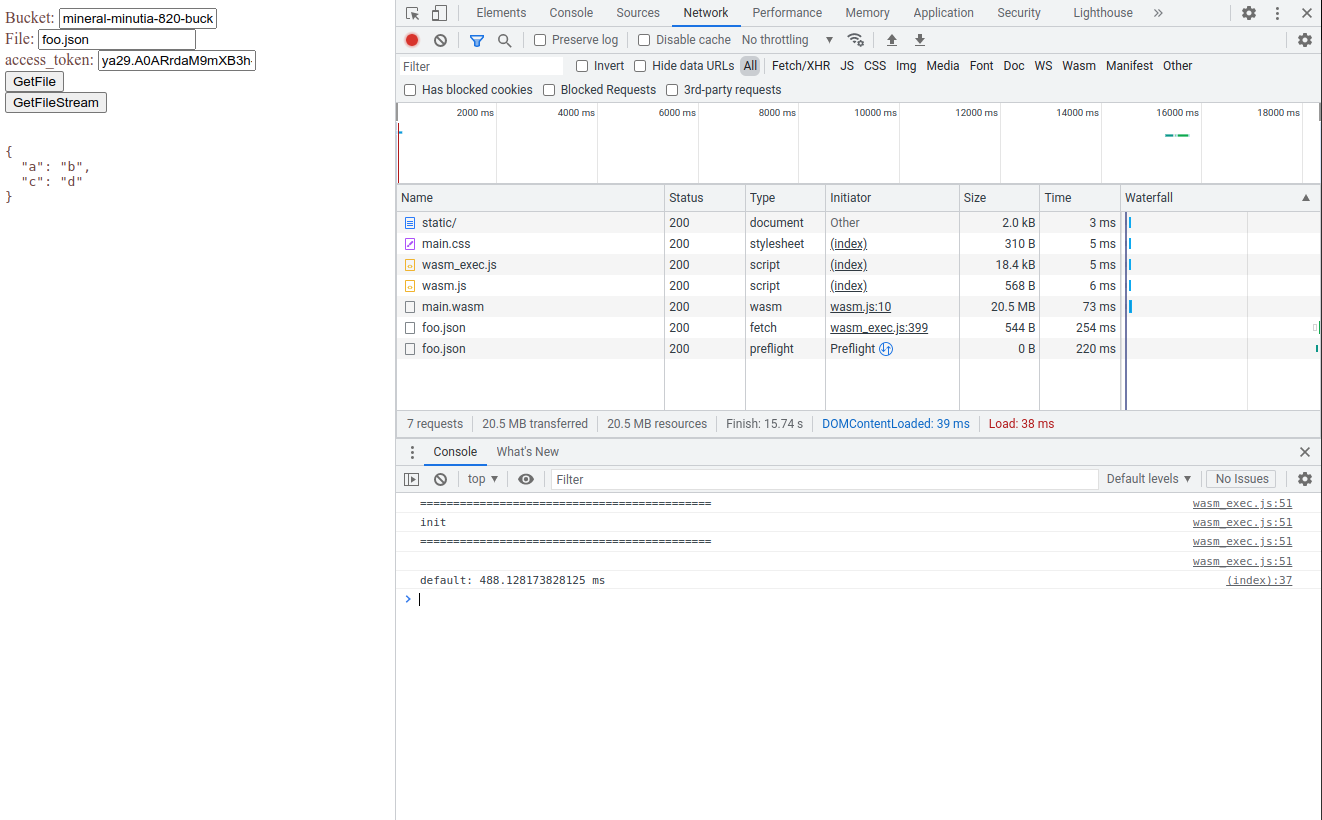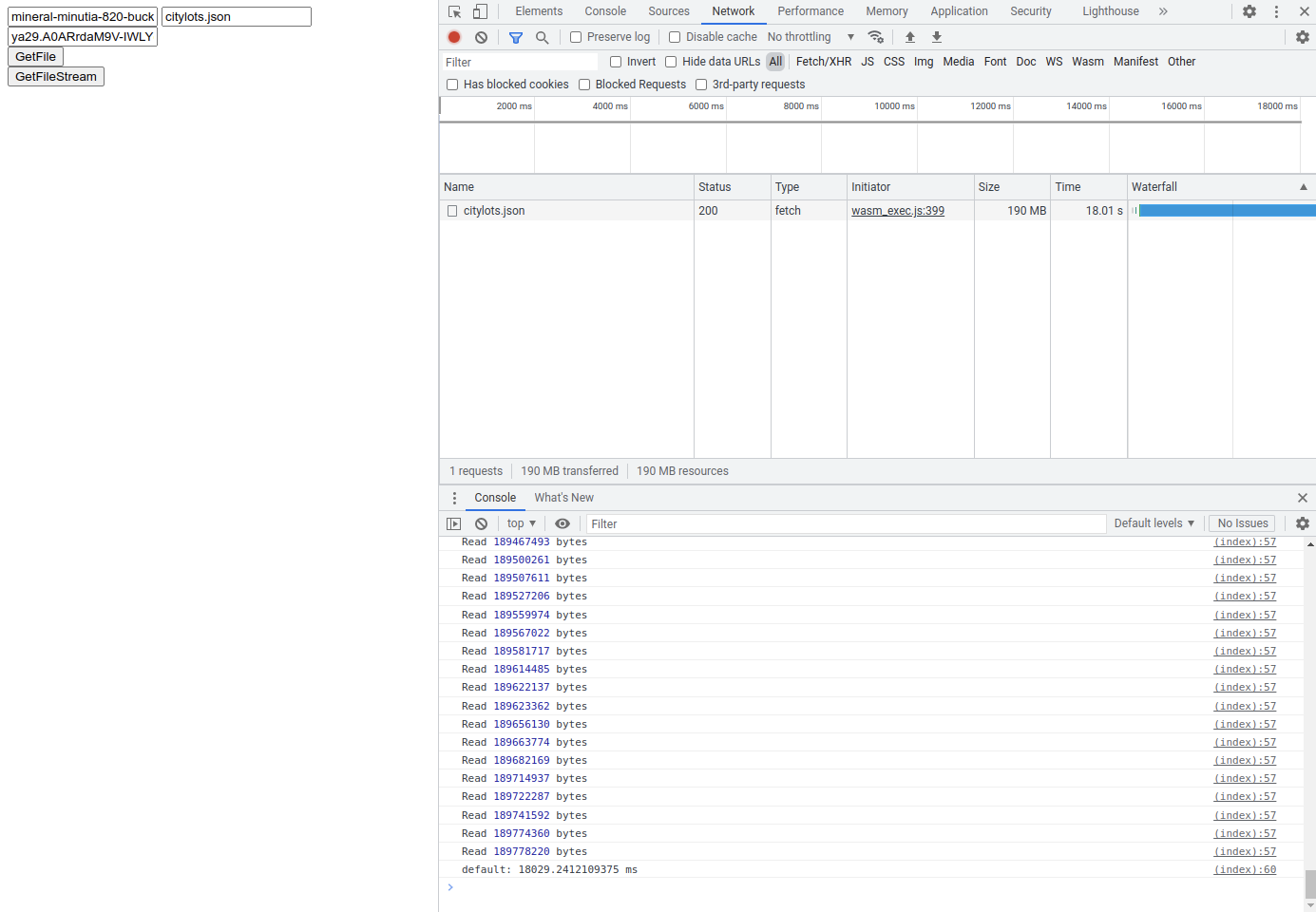Browser WebAssembly with Google Storage golang client library
2022-03-21Earlier today I realized go’s wasm net/http client actually uses javascript fetch() internally.
…so what?
What that means is you can just write some go code, use its default httpClient and pipe the output back even as a stream back to the browser.
This is really unexpected and I’ve detailed the basic flow here:
This article builds on top of that but instead of a simple web resource, i thought to bake in the full Google Cloud Storage Client Library into wasm.
Since the GCS client library currently uses REST/HTTP (not gRPC) and that uses the underlying httpClient….why not see if i can use gcs-go in browser webassembly?
If i could do that, then i can “just use” the client library to upload and download files as long as credentials are somehow passed to the client.
eg do this in wasm in the browser
client, err := storage.NewClient(ctx, option.WithTokenSource(ts))
bkt := client.Bucket(bucketName)
obj := bkt.Object(fileName)
r, err := obj.NewReader(ctx)
fastforward, thats what this article shows
You can find the source here
So lets get started…
Setup
Clone and compile the wasm binary yourself:
git clone https://github.com/salrashid123/wasm_http_gcs_go
cd wasm_http_gcs_go
GOOS=js GOARCH=wasm go build -o server/static/wasm/main.wasm main.go
The webserver i use here to host the ‘site’ uses the certificate SNI name of gcs.somedomain.com.
So lets setup a local redirect for that in /etc/hosts
127.0.0.1 gcs.somedomain.com
At this point, lets setup a GCS Bucket and upload a small test file
export PROJECT_ID=`gcloud config get-value core/project`
export PROJECT_NUMBER=`gcloud projects describe $PROJECT_ID --format='value(projectNumber)'`
echo -n '{"a":"b", "c":"d"}' > foo.json
gsutil mb gs://PROJECT_ID-bucket/
gsutil cp foo.json gs://PROJECT_ID-bucket/
Since we’re dealing with javascript we need to setup CORS on this bucket
cors.json:
[
{
"origin": ["https://gcs.somedomain.com:8080"],
"responseHeader": ["Content-Type", "Authorization", "Content-Length", "User-Agent", "x-goog-resumable","x-cloud-trace-context"],
"method": ["GET", "POST", "PUT", "DELETE", "OPTIONS"],
"maxAgeSeconds": 3600
}
]
gsutil cors set cors.json gs://$PROJECT_ID-bucket
## Test CORS
curl -v -X OPTIONS -H "Host: storage.googleapis.com" -H "Access-Control-Request-Method: GET" \
-H "Origin: https://gcs.somedomain.com:8080" \
"https://storage.googleapis.com/$PROJECT_ID-bucket/file.json"
ok, now start the webserver
cd server
go run server.go
get your current access token
gcloud auth print-access-token
In an incognito, goto https://gcs.somedomain.com:8080/static/
Ignore the certs warning
enter in your bucketName and access_token (again, the wasm isnt’ doing anything with your token, see the section in the appendix!)

a small file indeed
Appendix
Credentials
This sample expects you to provide webassembly your access_token. Why? well, it needs that to access the object you’re going to upload.
The code is provided in this repo and as you can see, it doens’t do anything other than utilize the client library itself (you can see the source and the go.mod for yourself!)
Your users will not be expected to copy-paste in the token..It could be provided through oauth2 single-page app webflow (though there’s real significant issue of scopes…which makes this not a good idea)
Better way would be if the access_token is provided to the client/browser through an external system which possibly already setup a DownScoped credentials.
Alternatively, you can setup federation using something like firebase: Federating Firebase to Google Cloud APIs
Be careful with the token or setting up firebase federation; i haven’t tested or security validated either. caveat emptor
The issue of how the user gets the token in the browser isn’t covered here in this article.
Larger files
We used a really small file here. To test with larger files, download something like the citylogs.json file (about 180MB)
wget https://raw.githubusercontent.com/zemirco/sf-city-lots-json/master/citylots.json
Then upload and test. But before you do, stop the server, edit index.html to not render it all in the browser (that’ll cause the browser to crash!)
async function GetFile(bucket, file, token) {
try {
console.time();
const response = await GetGCSFile(bucket, file, token)
const message = await response.json()
console.timeEnd();
} catch (err) {
console.error('Caught exception', err)
}
}
async function GetFileStream(bucket, file, token) {
try {
console.time();
const response = await GetGCSFileStream(bucket, file, token)
const reader = response.body.getReader()
let done = false
let totalBytes = 0;
while (!done) {
const read = await reader.read()
done = read && read.done
if (read.value) {
totalBytes = totalBytes + read.value.length;
console.log('Read', totalBytes, 'bytes')
}
}
console.timeEnd();
} catch (err) {
console.error('Caught exception', err)
}
}
Once you restart the server, hard-refresh the browser and test again. Remember to click the GetFileStream endpoint
For me, on my crappy verizon connection, download the citylots.json file took about 17.8s using gsutil
time gcloud alpha storage cp gs://$PROJECT_ID-bucket/citylots.json .
Average throughput: 10.8MiB/s
real 0m17.865s
user 0m2.348s
sys 0m1.943s
and on the browser, the same amount of time, 18s

my home for 12yrs
I also benchmarked 1.7G file which actually took the same here on my crappy connection: 2.6mins

the time to to download the lots for my home for 12yrs
TinyGo
As mentioned in the original article, its preferable to use TinyGo instead.
Using the default go-binary creates a fairly large file:
GOOS=js GOARCH=wasm go build -o server/static/wasm/main.wasm main.go
$ ls -larth server/static/wasm/main.wasm
20M Mar 21 14:48 server/static/wasm/main.wasm
This site supports webmentions. Send me a mention via this form.